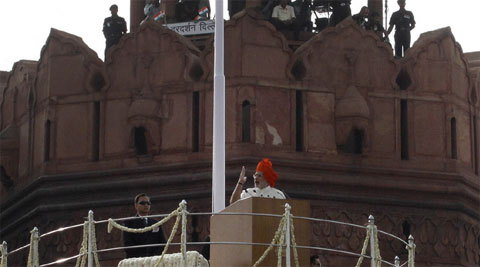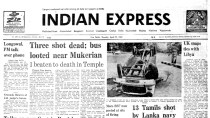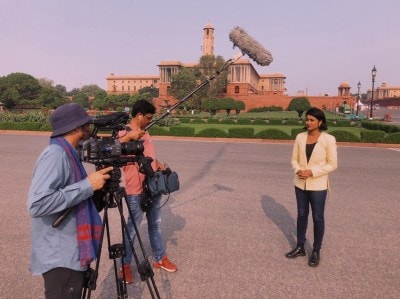- India
- International
Planning for a new India
New body must retain the Commission’s mechanisms for Centre-state discussion
 Prime Minister Narendra Modi used the country’s highest platform, its 68th Independence Day, to announce a new paradigm for this “institution”. (Source: Express photo by Renuka Puri)
Prime Minister Narendra Modi used the country’s highest platform, its 68th Independence Day, to announce a new paradigm for this “institution”. (Source: Express photo by Renuka Puri)
The prime minister spoke from the ramparts of the Red Fort this morning, putting to rest all speculation about the future of the Planning Commission. I write as a member of 10 years standing of this apex think-tank. The Planning Commission was the brainchild of Jawaharlal Nehru, who created it by cabinet order; it has no legislative sanction.
Prime Minister Narendra Modi used the country’s highest platform, its 68th Independence Day, to announce a new paradigm for this “institution”. He carefully avoided the use of the word “commission”, thereby removing the nomenclature of “Planning Commission” from government files. The new forum, he said, will be formed with states as primary stakeholders in the grand project of planning for the country. He was categorical that the old structure will not serve in the new world, where states are powerful entities and all have to pull together. In 2014, the Centre can no longer retain the driver’s seat.
When I look back at the last decade, I see evidence of the commission’s phenomenal output, especially in reports of ground realities and what needs to be done. These were not produced in the air-conditioned rooms of Yojana Bhavan or other boardrooms, but in the remotest parts of India: in Dharmapuri, Tamil Nadu; Kokrajhar, Assam; Halol and Kalol, Gujarat; Muzaffarnagar, Uttar Pradesh; Alwar, Rajasthan; Bilaspur, Chhatisgarh — I could go on and on. In his speech today, the prime minister also spoke about “another India” that he wants to see integrated with the rest of India, across the digital divide.
Whether it is time to change the aakaar of the Planning Commission was feverishly discussed within Yojana Bhavan during our term in UPA 2. Blueprints were drawn, experts consulted, papers written. We ensured that the process was inclusive; it involved members, senior officers, researchers — anyone from within the system and many from outside, such as NGOs, corporations and above all, the states. At joint meetings of the Planning Commission and state planning boards, we discussed alternative paradigms. At his last meeting with us, then prime minister Manmohan Singh asked us for new thinking and new directions in planning to meet contemporary challenges.
This is a watershed time for the commission. It is also time to reflect on its role, especially in the 10 years I witnessed its operations from the inside, and what needs to be retained within whatever form the new entity takes. The Planning Commission was to be an “essay in persuasion”, as Manmohan Singh said, for the states and sectoral ministries. Several platforms for this were provided within its framework. There were annual plan discussions with the states, quarterly and half-yearly reviews with ministries and one or two massive meetings of the National Development Council. Meetings were proposed (and some held) on specific cross-cutting issues such as water, energy and more recently, violence against women. My assessment is that we could have used these forums better to demand accountability from the ministries and states. Instruments were devised and applied, such as the results framework document, against which secretaries would asses their performance.

Reference to previous years’ discussions with states gave us an opportunity to rank them on their performance. By the same measure, states could express unhappiness with various aspects of Central plans and schemes. Solutions were proposed. Frank discussions yielded good results. This aspect of our work needs to continue in some institutionalised form. One or two NDCs are not sufficient.
The poet Ali Sardar Jafri said “guftgu bund na ho/ baat se baat chale”. The dialogue between the Centre and states needs many forums, so it keeps flowing. In this context the relationship we fostered with the state planning boards should be retained. It is likely that the announcement of change at the Centre will be followed by states. Whatever happens, it is important that the links beginning to be forged between the Central and state planning boards be encouraged.
The best part of my criss-cross journeys in India was the pools of goodness I found everywhere I went. In Gadchiroli, women lowered infant mortality by providing home-based neonatal care. In Jalpaiguri, young boys and girls created a protection ring to save villagers from elephant attacks. In Dewas, community effort stopped the heinous practice of lifting maila (rubbish) head loads by Valmiki and Hela women. In Ganiyari, a team of doctors created a decent hospital and dignified care for the poorest tribals. To project these as replicable practices is the work of planning, and this needs to continue. PPPPs — or public-private-people partnership — should also remain as a concept, because planning without the participation of people is mere ephemera. We, being the nodal entity for the NGO sector, provided a window for the concerned public who could partner with the government in carving their own destinies.
The writer is a former member of the Planning Commission
express@expressindia.com
EXPRESS OPINION
Must Read
More Explained
Apr 23: Latest News
- 01
- 02
- 03
- 04
- 05









































